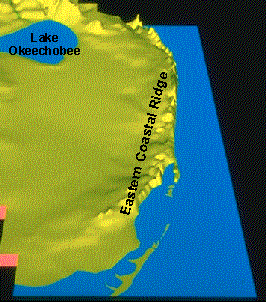

|
 |
The Eastern Coastal Ridge, which is necessary to retain water within the Everglades basin, owes its origin to marine geologic deposition which last occurred during the Sangamon interglacial age (about 125,000 YBP), when sea level was up to 8 meters above the present level. Repeated alterations between freshwater and marine conditions are revealed for interglacial times by the limestone rock record, with freshwater limestone layers occurring within the generally marine limestone sequence. Over the past 5,000 -- 6,000 years, the southern end of the Everglades trough, open to Florida Bay and the Gulf of Mexico, has had the continually rising sea again move across it, into previously freshwater habitats. Presently, the eastern coastal ridge can be identified in the Everglades region by uplands of pine forests and cypress hammocks on the eastern fringe of the Everglades.